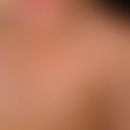Synonym(s)
HistoryThis section has been translated automatically.
E.Feer 1923
DefinitionThis section has been translated automatically.
You might also be interested in
ManifestationThis section has been translated automatically.
25 months to 7 years of age.
ClinicThis section has been translated automatically.
Initial changes in character: tearfulness, increasing apathy, possibly trichotillomania. After 2-4 weeks cold, moist, cyanotic, swollen hands and feet with coarse lamellar palmoplantar desquamation. Possibly generalized, itchy erythema. Severe hyperhidrosis up to miliaria rubra. In severe cases diffuse alopecia, loss of nails and teeth. Internal symptoms: tachycardia, arterial hypertension, marked fluctuations in blood sugar levels, generalized muscle weakness, sleep disturbances, weight loss. Photophobia, conjunctivitis. Possibly painful paresthesias. The children constantly rub their hands and feet, automutilation occurs.
LaboratoryThis section has been translated automatically.
Differential diagnosisThis section has been translated automatically.
TherapyThis section has been translated automatically.
LiteratureThis section has been translated automatically.
- Boyd AS et al (2000) Mercury exposure and cutaneous disease. J Am Acad Dermatol 43(1 Pt 1): 81-90
- Dinehart MD et al. (1988) Cutaneous manifestation of acrodynia (pink disease). Arch Dermatol 124: 107-109
Feer E (1923) On a peculiar neurosis of the vegetative system in infants. Erg.d inn Med u Kinderheilk 24
- Havarinasab S et al. (2004) Dose-response study of thimerosal-induced murine systemic autoimmunity. Toxicol Appl Pharmacol 194: 169-179
- Horowitz Y et al (2002) Acrodynia: a case report of two siblings. Arch Dis Child 86: 453
- Rütter A et al (1996) Metal dermatoses II. Dermatology 47: 400-409
Shekhawat R et al (2022) Acrodynia. In: StatPearls [Internet]. Treasure Island (FL): StatPearls Publishing; 2024 Jan-. PMID: 32644540.
Incoming links (10)
Acrodynia; Acroerythrosis indolens bechterew; Acroerythrosis paraesthetica; Erythema scarlatiniforme desquamativum recidivans; Feer's disease; Neurosis, vegetative of infants; Pink disease; Pink disease; Rare swift-feers disease; Swift syndrome;Outgoing links (7)
Antidote; Conjunctivitis; D-Penicillamine; Erythema scarlatiniforme desquamativum recidivans; Hyperhidrosis (overview); Miliaria rubra; Trichotillomania;Disclaimer
Please ask your physician for a reliable diagnosis. This website is only meant as a reference.




